
科技領(lǐng)域的成功一度取決于速度,,即快速行動,、打破常規(guī),并在此過程中不斷學(xué)習(xí),。速度仍然很重要,,那些遲遲不投入的人很快就會被淘汰。然而,,在實現(xiàn)人工智能潛力的競賽中,,這種方法可能行不通。
消費者采用人工智能的炒作和速度是前所未有的,。2006年,,推特(Twitter)用了近兩年時間才達到100萬用戶。2010年,,Instagram用了兩個半月,。而ChatGPT僅用了五天時間,在兩個月內(nèi)用戶數(shù)量就突破了1億,。
人工智能熱潮也在顛覆科技行業(yè)較為平靜的角落,。目前,全球有超過4萬家公司正在使用英偉達(NVIDIA)的芯片進行人工智能和加速計算,,而購買芯片的等待時間長達52周,。隨著AMD和英特爾(Intel)將推出與之展開競爭的硬件,微軟(Microsoft)和谷歌(Google)也宣布今年將在基礎(chǔ)設(shè)施領(lǐng)域投資數(shù)十億美元,,開發(fā)人工智能產(chǎn)品的競賽正在發(fā)生轉(zhuǎn)變,。焦點已經(jīng)從“能做什么”轉(zhuǎn)移到“如何去做”。
這種“現(xiàn)在購買人工智能,,以后再研究是否可行”的模式正是可能會危及人工智能創(chuàng)新可持續(xù)性的思維模式,。我們遇到了供需問題,而這不僅僅是芯片生產(chǎn)的瓶頸,,還是支持硬件所需的基礎(chǔ)設(shè)施的設(shè)計和開發(fā)方面的問題,。我們在未對管道進行投資的情況下打開了水龍頭。如果沒有對管道進行投資,,人工智能行業(yè)就面臨陷入錯誤開端的風(fēng)險,,可能會使其倒退數(shù)年,。
市場正在形成
數(shù)據(jù)中心是“如何去做”的關(guān)鍵,在過去十年的許多技術(shù)炒作周期中也是如此,。簡而言之,,數(shù)據(jù)中心的數(shù)量不足以滿足為生成式人工智能提供動力的要求,而芯片的銷售規(guī)模也表明了這一點,。我們正在進入一個高性能計算的時代,,而基礎(chǔ)設(shè)施還沒有到位來承載算力規(guī)模。這就是供應(yīng)問題的癥結(jié)所在,。人工智能前景令人振奮的地方在于它具有無限的可能性,。然而,即使硬件供應(yīng)有所改善,,必要基礎(chǔ)設(shè)施的匱乏也會限制發(fā)展,。
如今,建造新數(shù)據(jù)中心的開發(fā)周期為三到五年,,在某些情況下甚至更長,。那些進入人工智能市場的企業(yè)如果認為它們所需的基礎(chǔ)設(shè)施是現(xiàn)成的,那現(xiàn)實情況會讓它們感到震驚,。北美大部分預(yù)計將于2024年上線的數(shù)據(jù)中心供應(yīng)已經(jīng)提前發(fā)布,,或者已經(jīng)處于排他性狀態(tài)。
Epoch AI的研究人員估計,,人工智能的算力每6到10個月就會翻一番,。盡管數(shù)據(jù)中心建設(shè)不斷擴大,但如何滿足這一需求水平正成為一個全球性問題,。僅在歐洲,,到2025年,數(shù)據(jù)中心的管道需要增加一倍以上,,才能滿足預(yù)測的需求,。人工智能經(jīng)濟的基礎(chǔ)設(shè)施層對其成功至關(guān)重要。只有那些能夠確保實現(xiàn)訪問或進行相應(yīng)投資的企業(yè)才能生存下來,,更不必提及獲得優(yōu)勢了,。
壽命未定
數(shù)據(jù)中心運營商已經(jīng)將價格提高了30%,而且這一價格還將繼續(xù)攀升,。雖然少數(shù)公司有足夠的資金來應(yīng)對這一漲幅,并正在進行投資,,但許多規(guī)模較小的公司將發(fā)現(xiàn),,以他們能承受的價格找到空間和電力是一項挑戰(zhàn)。因此,,在大多數(shù)人有機會進行實驗,、迭代,、學(xué)習(xí)或做出積極改變之前,我們就面臨著市場整合,。
在這方面,,人工智能可以從數(shù)字資產(chǎn)領(lǐng)域得到啟發(fā)。隨著資產(chǎn)需求的增加,,滿足需求的承載能力受到越來越多挑戰(zhàn)的影響,,而這些挑戰(zhàn)在一開始并不明顯。加密貨幣及其生態(tài)系統(tǒng)通過保持敏捷的方法,,在很大程度上克服了這些問題,,例如,通過深入了解運營和能源效率的重要性,,以及優(yōu)化硬件以確保使用壽命和成本效益,。
大型科技公司正在投資數(shù)十億美元尋求掌握人工智能發(fā)展的控制權(quán),而且行動迅速,。這種模式我們以前都見過,。但這種模式是否應(yīng)該重來?雖然機會是真實存在的(普華永道預(yù)測,,到2030年,,全球經(jīng)濟將增長超過30萬億美元),但如何實現(xiàn)它將決定人工智能市場的健康和壽命,。
盡管雄心勃勃,,但人工智能的潛力取決于支持它所需的基礎(chǔ)設(shè)施承載能力。人工智能前景未定,,我們現(xiàn)在面臨著一個抉擇:是快速行動,,打破現(xiàn)狀,還是為未來而進行建設(shè),。(財富中文網(wǎng))
阿羅什·蒂萊納坦(Aroosh Thillainathan)是Northern Data Group的首席執(zhí)行官兼管理委員會主席,。
譯者:中慧言-王芳
科技領(lǐng)域的成功一度取決于速度,即快速行動,、打破常規(guī),,并在此過程中不斷學(xué)習(xí)。速度仍然很重要,,那些遲遲不投入的人很快就會被淘汰,。然而,在實現(xiàn)人工智能潛力的競賽中,,這種方法可能行不通,。
消費者采用人工智能的炒作和速度是前所未有的。2006年,,推特(Twitter)用了近兩年時間才達到100萬用戶,。2010年,,Instagram用了兩個半月。而ChatGPT僅用了五天時間,,在兩個月內(nèi)用戶數(shù)量就突破了1億,。
人工智能熱潮也在顛覆科技行業(yè)較為平靜的角落。目前,,全球有超過4萬家公司正在使用英偉達(NVIDIA)的芯片進行人工智能和加速計算,,而購買芯片的等待時間長達52周。隨著AMD和英特爾(Intel)將推出與之展開競爭的硬件,,微軟(Microsoft)和谷歌(Google)也宣布今年將在基礎(chǔ)設(shè)施領(lǐng)域投資數(shù)十億美元,,開發(fā)人工智能產(chǎn)品的競賽正在發(fā)生轉(zhuǎn)變。焦點已經(jīng)從“能做什么”轉(zhuǎn)移到“如何去做”,。
這種“現(xiàn)在購買人工智能,,以后再研究是否可行”的模式正是可能會危及人工智能創(chuàng)新可持續(xù)性的思維模式。我們遇到了供需問題,,而這不僅僅是芯片生產(chǎn)的瓶頸,,還是支持硬件所需的基礎(chǔ)設(shè)施的設(shè)計和開發(fā)方面的問題。我們在未對管道進行投資的情況下打開了水龍頭,。如果沒有對管道進行投資,,人工智能行業(yè)就面臨陷入錯誤開端的風(fēng)險,可能會使其倒退數(shù)年,。
市場正在形成
數(shù)據(jù)中心是“如何去做”的關(guān)鍵,,在過去十年的許多技術(shù)炒作周期中也是如此。簡而言之,,數(shù)據(jù)中心的數(shù)量不足以滿足為生成式人工智能提供動力的要求,,而芯片的銷售規(guī)模也表明了這一點。我們正在進入一個高性能計算的時代,,而基礎(chǔ)設(shè)施還沒有到位來承載算力規(guī)模,。這就是供應(yīng)問題的癥結(jié)所在。人工智能前景令人振奮的地方在于它具有無限的可能性,。然而,,即使硬件供應(yīng)有所改善,必要基礎(chǔ)設(shè)施的匱乏也會限制發(fā)展,。
如今,,建造新數(shù)據(jù)中心的開發(fā)周期為三到五年,在某些情況下甚至更長,。那些進入人工智能市場的企業(yè)如果認為它們所需的基礎(chǔ)設(shè)施是現(xiàn)成的,,那現(xiàn)實情況會讓它們感到震驚。北美大部分預(yù)計將于2024年上線的數(shù)據(jù)中心供應(yīng)已經(jīng)提前發(fā)布,,或者已經(jīng)處于排他性狀態(tài),。
Epoch AI的研究人員估計,人工智能的算力每6到10個月就會翻一番,。盡管數(shù)據(jù)中心建設(shè)不斷擴大,,但如何滿足這一需求水平正成為一個全球性問題。僅在歐洲,,到2025年,,數(shù)據(jù)中心的管道需要增加一倍以上,才能滿足預(yù)測的需求,。人工智能經(jīng)濟的基礎(chǔ)設(shè)施層對其成功至關(guān)重要,。只有那些能夠確保實現(xiàn)訪問或進行相應(yīng)投資的企業(yè)才能生存下來,更不必提及獲得優(yōu)勢了,。
壽命未定
數(shù)據(jù)中心運營商已經(jīng)將價格提高了30%,,而且這一價格還將繼續(xù)攀升。雖然少數(shù)公司有足夠的資金來應(yīng)對這一漲幅,,并正在進行投資,,但許多規(guī)模較小的公司將發(fā)現(xiàn),以他們能承受的價格找到空間和電力是一項挑戰(zhàn),。因此,,在大多數(shù)人有機會進行實驗、迭代,、學(xué)習(xí)或做出積極改變之前,,我們就面臨著市場整合。
在這方面,,人工智能可以從數(shù)字資產(chǎn)領(lǐng)域得到啟發(fā),。隨著資產(chǎn)需求的增加,滿足需求的承載能力受到越來越多挑戰(zhàn)的影響,,而這些挑戰(zhàn)在一開始并不明顯,。加密貨幣及其生態(tài)系統(tǒng)通過保持敏捷的方法,在很大程度上克服了這些問題,,例如,,通過深入了解運營和能源效率的重要性,以及優(yōu)化硬件以確保使用壽命和成本效益,。
大型科技公司正在投資數(shù)十億美元尋求掌握人工智能發(fā)展的控制權(quán),,而且行動迅速。這種模式我們以前都見過,。但這種模式是否應(yīng)該重來,?雖然機會是真實存在的(普華永道預(yù)測,到2030年,全球經(jīng)濟將增長超過30萬億美元),,但如何實現(xiàn)它將決定人工智能市場的健康和壽命,。
盡管雄心勃勃,但人工智能的潛力取決于支持它所需的基礎(chǔ)設(shè)施承載能力,。人工智能前景未定,,我們現(xiàn)在面臨著一個抉擇:是快速行動,打破現(xiàn)狀,,還是為未來而進行建設(shè),。(財富中文網(wǎng))
阿羅什·蒂萊納坦(Aroosh Thillainathan)是Northern Data Group的首席執(zhí)行官兼管理委員會主席。
譯者:中慧言-王芳
Success in technology was once determined by speed. Moving fast, breaking things, and learning along the way. Speed still matters and those slow to commit get counted out fast. However, the race to realize artificial intelligence’s potential might be the moment this approach comes unstuck.
The hype and pace of consumer adoption are unprecedented. In 2006, it took Twitter nearly two years to reach one million users. In 2010, it took Instagram two and a half months. For ChatGPT, it took just five days, with the service reaching 100 million users in a groundbreaking two months.
The AI frenzy is upending the quieter corners of the technology industry too. Over 40,000 companies across the world are now using NVIDIA chips for AI and accelerated computing, and the waiting list to purchase the chips is up to 52 weeks. With AMD and Intel set to launch rival hardware, and Microsoft and Google just some of those announcing multi-billion-dollar investments in infrastructure this year, the race to develop AI products is shifting gears. The focus has shifted from “what can be done” to “how we do it.”
This “buy AI now, figure it out if it works later” mode is the very mindset that could put sustainable AI innovation in jeopardy. We’ve got a supply and demand issue, and it is not just the bottleneck in the production of chips. It is the design and development of the infrastructure needed to support the hardware. We’re turning on the taps without investing in the plumbing. Without this, the AI industry risks a false start which could set it back years.
A market in the making
Data centers are the “how”–and have been for many of the technology hype cycles of the last decade. Put simply, there aren’t enough of them to meet the requirements of powering generative AI on the scale chips sales would indicate. We are entering an era of high-performance computing before the infrastructure is in place to house it. Here is the crux of our supply issue. What excites about the promise of AI is its limitless possibilities. Yet, even as the supply of hardware improves, the scarcity of the necessary infrastructure to house it will limit progress.
The development timeline to build new data centers is now between three to five years, or more in some cases. Those entering the AI marketplace thinking the infrastructure they need is readily available are in for a shock. Most of the data center supply in North America supposedly coming online in 2024 has been pre-released or is under exclusivity already.
Researchers at Epoch AI estimate that AI’s computational power is doubling every six to 10 months. Despite data center construction increasing, meeting this level of demand is becoming a global problem. In Europe alone, the pipeline of data centers needs to more than double by 2025 to meet the forecasted demand. The infrastructure layer of the AI economy is critical to its success. Only those able to secure access or invest accordingly will survive, let alone secure an advantage.
Longevity in the balance
Data center operators have increased their prices by up to 30%–and this will only continue to climb. While a few have the funds to match this increase and are investing themselves, many smaller players will find it challenging to find space and power at prices they can afford. We are therefore facing market consolidation before most have even had a chance to experiment, iterate, learn, or make positive change.
AI can take inspiration from the digital asset sector in this regard. As demand for the asset has increased, capacity to meet demand has been impacted by a growing number of challenges, which weren’t necessarily evident at the outset. Crypto and its ecosystem have largely overcome these issues by retaining an agile approach–for example, by developing a great understanding of the importance of operational and energy efficiency and the optimization of hardware to ensure longevity and cost-effectiveness.
Big Tech is investing billions of dollars, seeking to seize control of the development of AI–and they are moving quickly. It’s a pattern we have all seen before. But should it be repeated? While the opportunity is real (PWC predicts a boost to the global economy of over $30 trillion by 2030), how it is realized will determine the health and longevity of the AI marketplace.
Despite the bold ambition, the potential of AI is only as great as the infrastructure capacity needed to support it. AI is in the balance, and we now face a choice to move fast and break things or build for the future.
Aroosh Thillainathan is the CEO and chairman of the management board at Northern Data Group.






